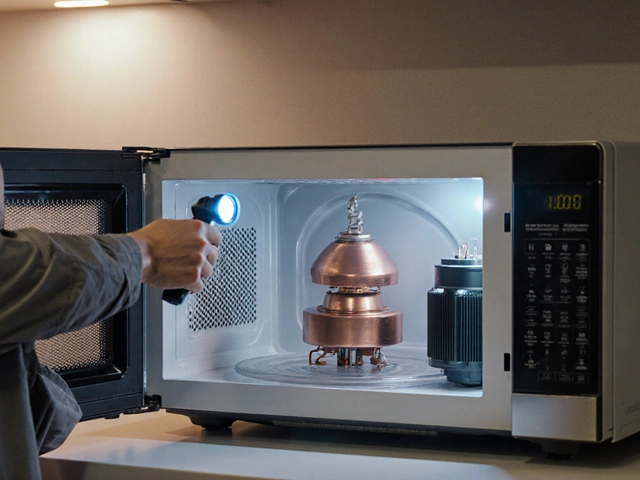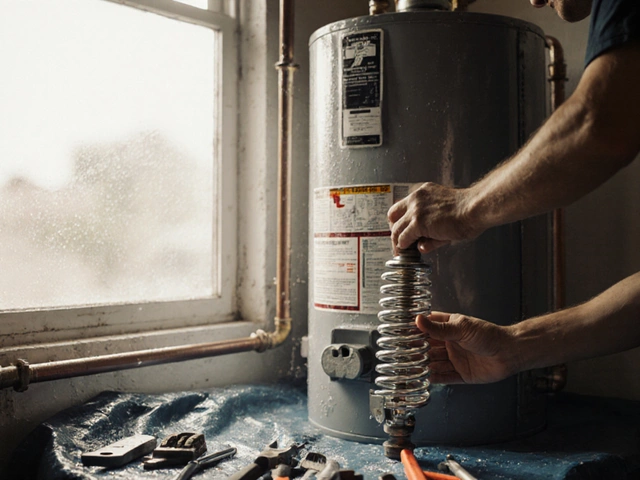Taking on the task of installing an extractor fan yourself can be empowering and rewarding. Whether it's for your kitchen to reduce smoke and steam or for the bathroom to battle mold and moisture, a good extractor fan is crucial for maintaining air quality and comfort in your home. But where do you start?
For DIY enthusiasts and homeowners alike, it's crucial to understand the basics before diving into this project. With a bit of planning and the right tools, many find it simpler than they initially feared. Along the way, you'll likely pick up a few handy skills that can apply to future home improvement projects.
In this article, we’ll cover the various types of extractor fans available, what you might need in terms of tools and equipment, and a straightforward guide to the whole process. Let's ensure you have the knowledge and confidence to get the job done right.
- Understanding Extractor Fan Types
- Tools and Equipment Needed
- Step-by-Step Installation Guide
- Troubleshooting and Maintenance Tips
Understanding Extractor Fan Types
When embarking on the journey of extractor fan installation, it's crucial to recognize that not all fans are created equal. The type of extractor fan you choose largely depends on its intended location and purpose within your home. Broadly, extractor fans can be categorized into axial, centrifugal, and mixed flow, each designed with specific applications in mind. Axial fans, for instance, are popular in bathrooms and small kitchens due to their straightforward design, ideal for propelling air directly through a wall or window. They are best suited where the duct run is short, often delivering just the necessary punch to keep your air clean and fresh without unnecessary bells and whistles.
Centrifugal fans, on the other hand, are often selected for areas where the duct path might take a twisty and lengthy route. These fans generate higher pressure and are more efficient at moving air through long ducts. If you're dealing with internal rooms or spaces where the exterior wall is remote, these workhorses help in ensuring that the stale air is whisked away effectively. A telling example of their application is in large kitchens or bathrooms where moisture or cooking odors can linger stubbornly. As for mixed flow fans, these offer a blend, borrowing properties from both axial and centrifugal types, striking a balance in performance that makes them versatile across various set-ups. These fans are often quieter while providing strong airflow, which makes them suitable for noise-sensitive areas.
Another interesting differentiation is whether an extractor fan is installed as a wall-mounted, ceiling-mounted, or window-mounted unit. Wall-mounted fans are typically easier to install and maintain, often providing a cost-effective solution for straightforward ventilation needs. Ceiling-mounted fans are more discreet and take advantage of the space within your ceiling cavity, an asset when clean lines and minimal interruption to your decor are desired. Window-mounted units are fewer in design variety but serve a niche where wall installations are impractical, allowing for easy expulsion of air directly outside. According to a study by the National Home Improvement Council, more than 70% of UK households now prefer extractor fans with timer or humidity sensors to aid energy efficiency and promote better indoor air quality.
"The secret to choosing the right extractor fan lies in your understanding of both the scope of ventilation required and the design constraints inherent to your home," suggests Heather Smiley, a well-regarded interior design expert. She emphasizes that a poor choice might lead to inefficiency and unnecessary energy consumption, not to mention the ire of persistent lingering odors or humidity.
Choosing wisely involves assessing your individual needs, noting factors like the size of the room, the likelihood of excessive moisture, and your budget, among other things. For instance, a bathroom may require a model with a moisture sensor that activates when humidity reaches a certain level. Meanwhile, kitchens benefit from high-capacity fans to handle steam and smoke from cooking. As you weigh your options, remember that today's market is replete with innovative designs that cater to both the functional and aesthetic aspects of modern homes, allowing homeowners to ensure good ventilation without compromising on style or practicality. If you're grappling with selecting the right model, consulting a professional or seeking advice at a home improvement store can set you on the right path.

Tools and Equipment Needed
Embarking on the journey of installing an extractor fan in your home is like setting sail on a well-charted expedition. Getting equipped with the right tools is not just sensible; it's essential. The success of your DIY project hinges on having these key items at hand, and knowing which tool does what is half the battle won. To begin with, a reliable power drill will become your best friend during this task, as the process often involves making precise holes and fixing the fan securely. Pair it with a set of good-quality drill bits, ranging in sizes to match the specific requirements of your model.
Beyond the basics, you'll also require a stud finder. This is crucial for walls where support beams need to be located to ensure you're not drilling into something unintentionally disastrous or damaging. Tape measures are indispensable for getting accurate dimensions, ensuring the fan fits perfectly into the designated space. A jigsaw is highly recommended for creating larger openings in wood or drywall, especially if you're replacing an old fan with a differently sized new one. Have a durable utility knife on hand for trimming excess insulation and tidying any raw edges. Safety should never be compromised, so protective gloves and safety goggles are essential kit to keep you safe from debris and harm.
"Having the right tools makes any home improvement job more straightforward and less daunting," explains Joanna Gaines, renowned for her practical approaches to DIY projects. "Investing in good equipment can turn a complex task into a simple one."
For specialized extraction fan installation, adding a few more items to your toolbox is wise. You'll need a wire stripper to manage any electrical connections, given most fans require wiring into the main household circuit. A circuit tester assures you that circuits are dead before any electrical work begins, which is pivotal in avoiding any nasty shocks. A spirit level ensures that everything sits evenly, preventing future issues with an uneven fan. Flashlights or headlamps are brilliant, quite literally, offering the necessary lighting if you’re working in dim or cramped conditions. And, finally, sealant or caulking ensures your hard work remains impervious to air and water leaks.
Gathering Your Equipment
Before diving headlong into the installation process, gather your arsenal. Organizing your toolkit in advance helps to streamline the installation process, minimizing interruptions caused by hunting down elusive devices. When all equipment is in place, perform a double-check to ensure nothing critical is missing. This foresightedness can save you both time and frustration.
Proper preparation cannot be overstated, especially when it comes to DIY extractor fan installation. From novice to veteran DIY enthusiast, having everything ready at the start is a golden rule that holds true time and again. So lay out your tools, familiarize yourself with every piece, and you'll be swiftly moving from tool gathering to fan installation in no time.
Cost Considerations
The initial investment in quality tools often deters many DIYers. However, this shouldn't be viewed as a hurdle but rather a beneficial long-term strategy. Quality tools offer durability and efficiency, providing a smoother experience during installation. Additionally, most of these tools will come in handy for other household jobs, making their value extend well beyond this one project. Often the upfront cost is offset by the satisfaction and savings derived from completing the task independently.
To provide a quick look at potential costs, a basic table of approximate prices for each tool type can highlight budgeting requirements:
| Tool | Approximate Cost ($) |
|---|---|
| Power Drill | 50-150 |
| Drill Bits | 10-25 |
| Stud Finder | 20-50 |
| Jigsaw | 40-100 |
| Wire Stripper | 10-20 |
| Safety Equipment | 10-30 |
Now that we're geared up with both knowledge and equipment, you're one step closer to achieving a seamless home ventilation solution. Armed with your tools, the next stage involves action, applying the tools with skill and a bit of daring.

Step-by-Step Installation Guide
Tackling the installation of an extractor fan on your own might seem daunting, but with the proper guidance, you’ll find it a manageable and even enjoyable task. Before you begin, it's important to assess the location of your installation. Bathrooms and kitchens are common spots due to their high moisture and odor output. Identifying the best placement for your fan is vital. Ensure that it’s positioned where air can flow freely, ideally in the ceiling or a high wall spot. If walls are thicker than usual, you might need longer screws or additional mounting hardware, which is a factor worth considering.
Once you’ve decided on the location, gather your tools—these generally include a drill with appropriate bits, a screwdriver, a stud finder, and a jigsaw. Having all these ready before you commence will save you from interruptions. Now, let’s dive into the specific steps of the installation process. With patience and precision, each step will lead you closer to better ventilation at home.
Preparation and Planning
First, ensure that the power is turned off in the circuit you’ll be working on. It’s not only a preventive measure but a critical safety requirement. With safety goggles and gloves on, take time to review your fan’s manual, as there might be specific instructions you need to follow. Planning also includes checking your walls and ceilings for any hidden wires or pipes, using a stud finder if necessary. Mark the exact spot where the extractor fan will be installed. This step will prevent accidental damage to existing utilities and ensure the best placement for performance.
In an insightful quote from DIY expert Mike Holmes, he reminds us,
"Always measure twice and cut once; preparation is key in any home improvement project."Take this advice to heart, as careful preparation often dictates the success of DIY projects.
Creating the Opening
With your spot marked, use a pencil to outline the shape of the fan’s cover. This outline serves as a guide for cutting. Employ a jigsaw to cut along the outline; remember to go slowly and apply steady pressure for a clean cut. It’s important that the opening isn’t too large or small since either would compromise the installation. Once the opening is ready, clean the edges to ensure there are no splinters or debris remaining, which could interfere with securing the fan in place.
Additionally, if you're venting the fan through an exterior wall, you may need to install additional ducting. While some people opt to vent into the attic, this approach can create moisture problems down the line. Always aim to channel the exhaust outside to prevent internal damage and maintain fresh air within your home environment.
Mounting the Fan
Now comes the crucial part of mounting the fan. Insert the fan body into the opening and use your drill to secure it according to manufacturer guidelines. If your fan requires ducting, connect this diligently, ensuring it fits snugly to avoid air leaks. Pay attention to any anti-vibration mounts or inserts; these are essential for reducing noise, which can become a nuisance over time.
Match your fan's wiring with the existing house wiring. Use wire connectors to ensure a tight and safe connection. Turn the power back on and test the fan to see if it operates smoothly. Should there be an issue, double-check the wiring and make sure all connections are secure. Once confirmed, attach the cover, using screws to secure it firmly.
Final Adjustments and Testing
With the fan securely mounted, observe it in operation a few times. Listen for any unusual noises, which could indicate a loose part or improper fitting. The fan should be quiet and effective. Consider putting a piece of paper near it to check the suction; proper airflow will cause the paper to be drawn towards the grille easily.
If you're satisfied with its performance, congratulations! You've successfully completed your DIY extractor fan installation. This process not only provides enhanced air quality in your living space but also adds a valuable skill to your repertoire. It's a task that, when executed with care and precision, can make a noticeable difference in the comfort and quality of your home’s environment.

Troubleshooting and Maintenance Tips
When it comes to maintaining your extractor fan, regular upkeep can go a long way in keeping your fan functioning effectively. First off, one of the most common issues you might encounter is a fan that simply doesn’t turn on. Before you panic, check whether the circuit breaker has tripped or if there is a blown fuse. Electrical issues can often be traced back to a simple power problem, and resolving this might be as easy as flipping a switch or replacing a fuse.
Another issue homeowners frequently face is excessive noise from the DIY extractor fan. This can be a clear indicator of accumulated dust or debris in the fan. It is advisable to clean the fan blades and the interior compartments regularly. Using a soft brush or a can of compressed air can effectively remove dust and dirt. Noise can also emanate from parts that have become loose or worn out, so inspect the mountings and replace or tighten them as necessary.
Addressing Performance Problems
If your extractor fan seems to be underperforming, consider checking the ventilation pathways. Often, blockages in the ducts can restrict airflow, reducing the fan’s efficiency in clearing smoke or moisture. Inspect the ductwork for any obstructions or kinks that might impede airflow, and adjust or clean as needed. According to a study in the Journal of Building Physics, ensuring proper ventilation pathways can increase a fan's efficiency by up to 20%. With these statistics in mind, maintaining clear ducts can significantly bolster the fan's performance.
It’s also worthwhile to listen to your fan when it’s operating. An unusual sound might indicate a problem with the motor or the bearings. In such cases, these often need to be replaced by a professional, especially if the fan was newly installed. As electrician Mark Johnson says, “Ignoring these sounds can lead to more severe issues, potentially resulting in total fan failure.”
Routine Maintenance Practices
Implementing a regular maintenance schedule can prevent a lot of common issues from developing in the first place. Aim to clean the fan and its components at least every three months. This not only improves its efficiency but also extends its lifespan. Also, check for any signs of wear and tear around the mounting and the fan cover, signs like cracks or brittleness should be addressed promptly. Periodic checks and minor repairs can go a long way toward keeping your home ventilation system in prime working condition.
Key Points to Remember
- Regularly check and clean the fan blades.
- Monitor and maintain unobstructed ventilation pathways.
- Listen for unusual noises that could indicate internal issues.
- Inspect the electrical connections and fuses regularly.
- Follow a routine maintenance schedule to prolong the fan’s lifespan.
By following the tips above, your efforts in installing the extractor fan will not go to waste. With consistent care, your home ventilation will always be in top-notch shape.





